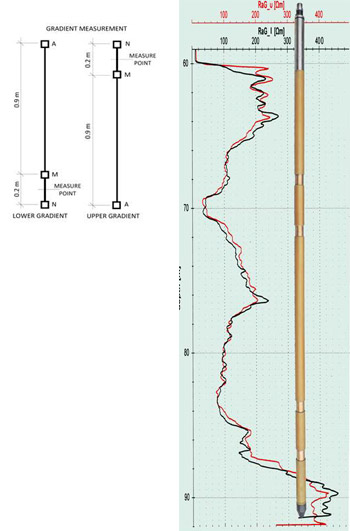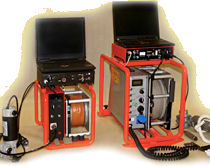Lower - Upper Gradient Resistivity HR-380 Glu
General Two ways of resistivity of rocks measurement:
a) Standard Potential measurement. The distance between paired electrodes M and N is longer (1000 mm) and distance from the unpaired electrode A is small (see data sheet HR-380 P Potential).
b) Gradient Resistivity measurement. The distance between the paired electrodes M and N is short (200 mm). The unpaired electrode A is in longer distance (900 mm). When this type of measurement is used we distinguish between lower (RaG_I) and upper (RaG_L) gradient of resistivity (see pict.A and the diagram)).
The HR Glu is constructed for measuring of apparent resistivity Ra down the borehole whose value is a function of all true resistivities of the medium existing within the depth of investigation of probe including mud cake and invaded zone.

Probe Parameters
| Available in diameters | 38 mm and 45 mm |
| Length | 2000 mm |
| Weight | 5,0 kg |
| Max. Working Pressure / Temperature | 10 MPa / 75 °C |
| Power Supply | 45 Vdc @ 120 mA |
Excitation frequency is 81 Hz; Operated on one conductor cable. Output signal is in form of frequencies of pulses of amplitudes of 8V and widths of 6 µs (amplitude and width are adjustable).
Measurement
When winching the probe down, the electrodes for "Lower Gradient" are active and data are registered. After reaching the bottom of the borehole movement is switched to upwards the electrodes for "Upper Gradient" are active, Both curves ( RaG_u and RaG_I) will be drawn to one diagram. The probe is calibrated and the output frequency is directly proportional to the resistivity of measured rocks. The distance between electrodes can be designed in accordance with the customer's need.

